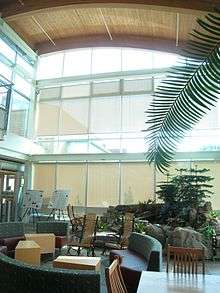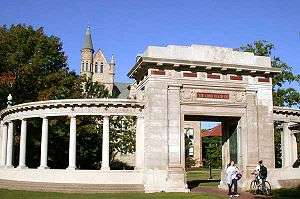Adam Joseph Lewis Center for Environmental Studies
The Adam Joseph Lewis Center for Environmental Studies, located on the campus of Oberlin College, is one of the most advanced examples of Green building in the United States. Construction crews completed work on the building in January 2000. The following semester, classes in conservation biology, environment and society, sustainable agriculture, ecological design, environmental education, physical geology, and solar energy were held in the center.[1] It would have qualified as a LEED Platinum building had it not been built before the LEED system was established.[2] John T. Lyle who was the lead designer for the Lyle Center for Regenerative Studies was also the landscape architect for the project, the main plaza is named in his honor. The project's lead architect was William McDonough + Partners, an architectural firm in Charlottesville, Virginia.[3]
Awards
The building has received many awards, including:[4]
- Most important green building constructed in the last 30 years (July 2010), Architect Magazine
- One of the 30 Milestone Buildings of the 20th Century, U.S. Department of Energy, William McDonough & Partners
- One of the Top 10 Green Projects (2002), American Institute of Architects (AIA)
- Build America Award (2001), National Convention of the Associated Contractors of America, Mosser Construction
- Build Ohio Award (2000), Associated Contractors of Ohio, Mosser Construction
- Honor Award (1999), AIA Committee on Architecture and Education, William McDonough & Partners
- American Architecture Award (1999), Chicago Anthaeum, William McDonough & Partners
References
- ↑ "Oberlin College Campus Map". Retrieved 26 July 2017.
- ↑ "Oberlin College". The College Sustainability Report Card. Sustainable Endowments Institute. 2008. Retrieved 2009-02-21.
- ↑ "Breaking New Ground". www.oberlin.edu. Retrieved 26 July 2017.
- ↑ "Adam Joseph Lewis Center for Environmental Studies at Oberlin College". Retrieved 26 July 2017.
Further reading
- Orr, David W. (2006). Design on the Edge: The Making of a High-Performance Building. MIT Press. ISBN 0-262-15117-0.
External links
Coordinates: 41°17′26″N 82°13′17″W / 41.290601°N 82.221414°W


